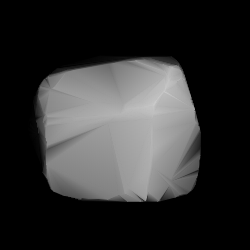 Modeled shape of Scheherezade | |
| Discovery | |
|---|---|
| Discovered by | August Kopff |
| Discovery site | Heidelberg Obs. |
| Discovery date | 8 September 1907 |
| Designations | |
| (643) Scheherezade | |
| Pronunciation | /ʃəˌhɛrəˈzɑːd/ [1] |
Named after | Sheherazad |
| 1907 ZZ | |
| Orbital characteristics [2] | |
| Epoch 31 July 2016 (JD 2457600.5) | |
| Uncertainty parameter 0 | |
| Observation arc | 108.57 yr (39655 d) |
| Aphelion | 3.5551 AU (531.84 Gm) |
| Perihelion | 3.1656 AU (473.57 Gm) |
| 3.3603 AU (502.69 Gm) | |
| Eccentricity | 0.057954 |
| 6.16 yr (2249.9 d) | |
| 162.557° | |
| 0° 9m 36.036s / day | |
| Inclination | 13.769° |
| 252.201° | |
| 230.826° | |
| Physical characteristics | |
| 35.785±1.4 km | |
| 14.161 h (0.5900 d) | |
| 0.0446±0.004 | |
| 9.7 | |
643 Scheherezade is a minor planet orbiting the Sun. It was named after the fictional storyteller Sheherazad.